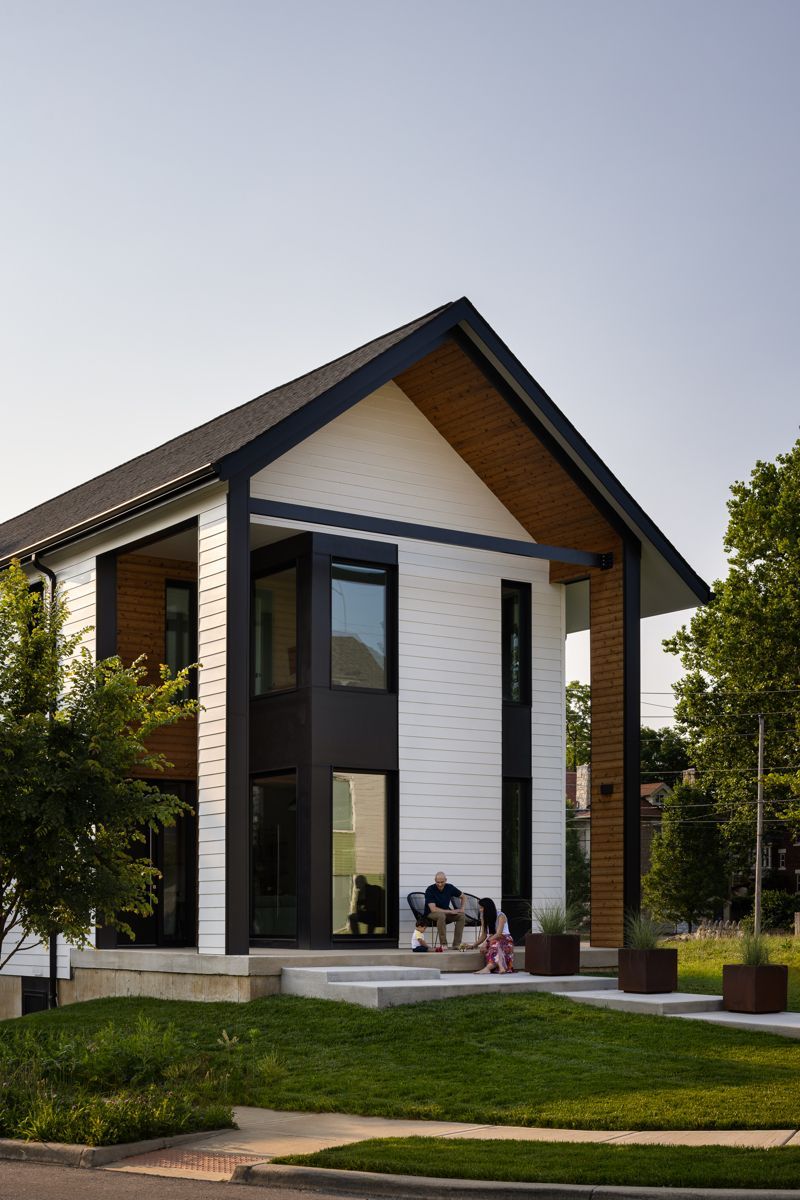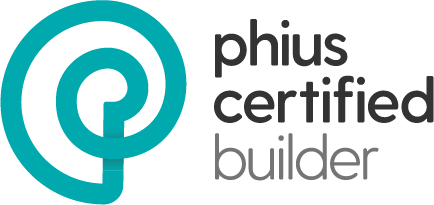Beacon Hill Passive House
What’s it like to live in the first Phius-certified Passive House in Missouri? Nic and Pooja describe why they wanted to build better in Kansas City’s historic Beacon Hill neighborhood.
Specs & Details
NEIGHBORHOOD
Beacon Hill
SIZE
2,600 Square Feet
BEDS
4
BATH
3
TEAM
FEATURES
Featured in Design KC, Spring 2023, “Live + Stay + Play”, pg. 70
Featured on 2023 KC Design Week “Homes By Architects Tour”
The least we could do is build the best home we could build.
Nic, homeowner
Comfort
Previously, Nic and Pooja lived in a condo in Kansas City’s Power & Light District. While it’s a desirable, vibrant area that put them just steps away from live music, excellent dining, and other attractions, that home also had drawbacks. “You couldn’t beat the location, we had enough space, and we loved the views, but it just wasn’t comfortable,” Nic said. “The air conditioner was on full blast all the time because no matter what temperature we wanted it, it had to work hard to keep it there so there was always background noise.”
Unlike a traditional home that relies on an HVAC system noisily going into high gear to provide heat in the winter and cooling in the hot and humid Midwest summer, a Passive House uses a heat pump and whisper-quiet ERV system to maintain a pleasant temperature year-round. “The one thing I find most valuable is the comfort of the home,” Pooja said. “Ever since we've built this house, we'll go stay somewhere and I’ll tell Nic, ‘Gosh, I can appreciate the comfort of our home, the steadiness of the temperature, and how it doesn’t fluctuate.’ It can be the dead of winter and I’ll walk around in shorts and a t-shirt and be totally fine and comfortable.”
Health
Once Nic had thoroughly researched Passive House construction principles and decided to partner with Kala to build a new home, he realized that when it comes to his family’s vitality, there would be a beneficial effect to living in a thoughtful space designed with health in mind. “The first day you skip brushing your teeth, it's not like they’re going to start rotting, but you’ve got to have consistent habits and make good decisions,” he said. “This home allows us to do that without thinking too much about it.”
The almost silent circulation of fresh air in Pooja and Nic’s home creates a pervasive sense of calm both day and night. Filtering clean air in while taking vapors and odors out combined with an airtight building enclosure keep allergens, pollutants, and other irritants at bay.
“I’m sleeping better, which is important for mental and physical health and very valuable to me,” Pooja said. “Being in the healthcare field, I’ve seen diseases that can occur because of air pollution, and it can cause quality of life issues. So when you have the option to do something that’s going to be healthier, it makes sense to do that. Our son is as healthy as he can be in the environment that we control.”
Durability
When Nic and Pooja decided they wanted to construct a new home that was long lasting, they realized that doing so wouldn’t merely lower maintenance costs or provide their son a healthy environment to grow up in, but it could also leave a positive legacy for their family and in Beacon Hill.
“It's going to last beyond us,” Nic said. “This is not just our house. Whether it's our family's home, or generations of families after us who are going to live here, it’s going to impact lots of people. There's a lot to be said about investing in a neighborhood so that it stays vibrant. I thought that was a responsibility here. The city subsidized our purchase of this land, so the least we could do was build the best home we could.”
From the design phase through each stage of construction, Kala worked closely with Nic and Pooja to create a ruggedly built home that would stand the test of time. “It's not just about saving energy, but also building something that will last.” Nic said. “There are simple things you can do every step of the way to make things last longer, like adding rain screens, using certain paint, and adding a metal roof that will allow us to install solar. We also thought of the mechanical systems as part of the enclosure. We had this intentionality of making sure that this home is going to be here for the long term.”
Sustainability
As part of the Phius certification process, a third party energy rater completed a report which gave Nic and Pooja’s home a HERS rating of 32, which means it’s 80 to 90 percent more energy efficient than the average Kansas City home, saving approximately $200 a month on utilities. But for them, constructing a sustainable home means more than mere numbers. “When I think of sustainability, I think of strength,” Pooja said. “100 years from now, our house will probably still be standing and be in reasonable shape, because it’s strong.”
The combination of durability and sustainability was a driving factor when Nic first approached Kala about building him and Pooja a home built to high Passive House standards that ensured low energy consumption and a robust structure.
“At a local TED Talk, an entrepreneur said, ‘The best way to sustain something is to create and maintain it in a way that people love it,” Nic added. “This house was an opportunity for us to make our own kind of impact. If we could do it in a way where this home is here in 100 years and build something worth caring about, then that's going to be way better than purchasing perhaps a product that will maybe not exist in 50 years. We put our best foot forward, and hopefully, it will be around for a long time and use a lot less operational energy.”





